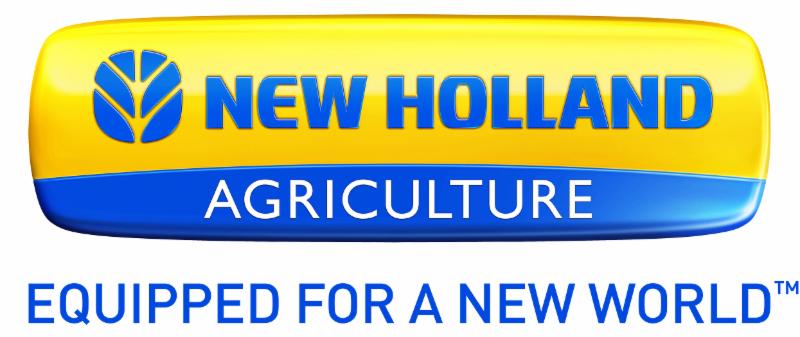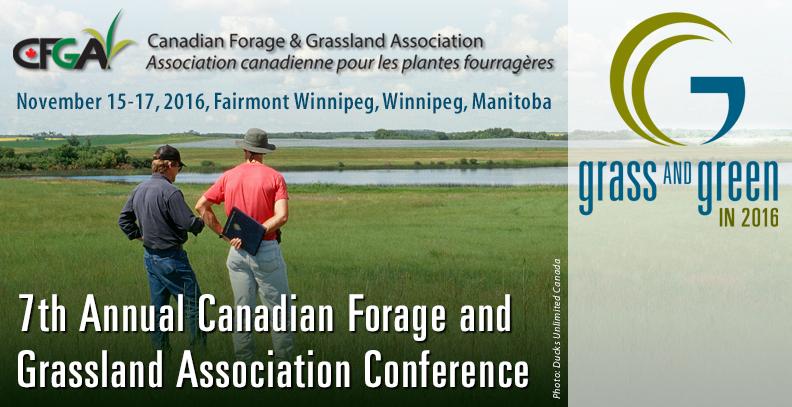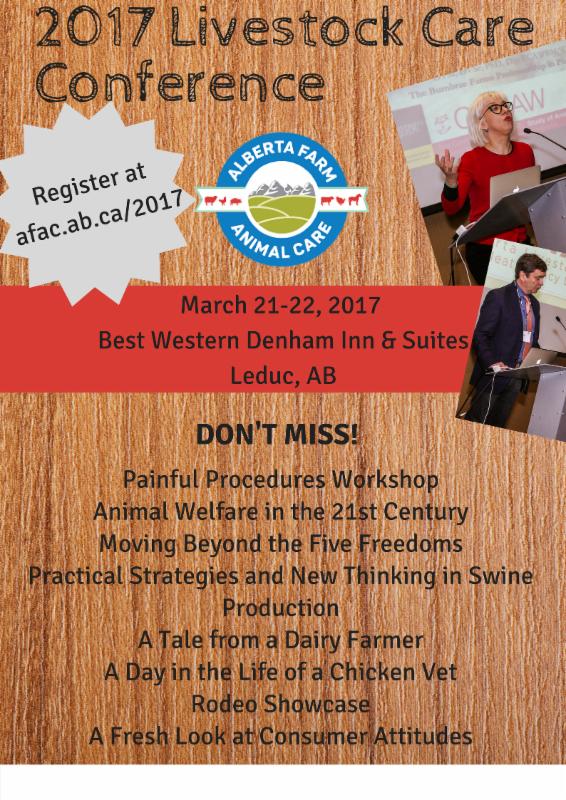|
Get to Know Your Researcher
|
Dr. Bruce Coulman
University of Saskatchewan
|
Winner of the 2015 CFGA Leadership Award, Dr. Bruce Coulman is a leader in Canadian forage development. He is a professor and former head of the Plant Sciences Department at the University of Saskatchewan where his research focuses on breeding perennial forage grasses and annual cereal forages, and forage agronomy.
Dr. Coulman has been involved in the development and registration of over 20 forage cultivars through his work at Macdonald College of McGill University, the University of Saskatchewan, and Agriculture and Agri-Food Canada.
CFGA asked Dr, Coulman for his opinion about current forage research, where he sees it going in the future and what he is currently working on.
|
|
 |
|
Greetings From the CFGA Chair
|

As we move into the Fall season, it brings us closer to our annual conference and meeting.
Each year, our annual conference is hosted in a different region of the country and offers a great opportunity to gain more insight into the diversity of Canada. Our first conference was held in Winnipeg, and we have now come full circle as our 7th annual conference will be back in Winnipeg, Nov. 15 to 17, 2016. The theme for this year's conference is "Grass and Green in 2016" and the conference has developed an excellent reputation for being a "Must Attend Event." Advanced registration is now available at a reduced rate until Sept. 30, so time is short. For registration, and further information, please visit the CFGA conference website.
For those who attended that first meeting, you will recognize how the organization has grown. I must pay tribute to our first executive director, Wayne Digby, who along with our current financial officer, Chris Yuzdepski, and a number of enthusiastic and dedicated directors across the country, contributed so much to get the CFGA off the ground. I also want to recognize our current executive director, Cedric MacLeod, who has been on the job for just over a year. Yes, there is much more to do, but a great foundation has been laid.
Given the extent of our industry, the numerous industries we service and the economic activity that we generate, we certainly have reason to celebrate the Canadian forage industry. Forages are getting more airtime and there is a growing awareness of the major role that forages and grasslands play, not only on our individual farm operations, but also in the broader country landscape and the sustainability they provide for the future.
I urge you to register for the conference and help us celebrate "Grass and Green in 2016."

Ray Robertson, P.Ag.
Chair, Canadian Forage & Grassland Association
|
 |
News from the Manitoba Forage and Grassland Association
|
MFGA Aquanty Project Accelerates for Assiniboine River Basin
Province of Manitoba officially signs on to flood and drought planning model
|
|
The pieces are all falling into place for the Manitoba Forage and Grassland Association (MFGA) Aquanty Modelling Project for the Assiniboine River Basin.
"The project seeks to develop new risk management tools to reduce the impact of extreme flood or drought events for the agricultural industry within the basin," explains Henry Nelson, vice-chair with MFGA and Aquanty project lead.
In recent years, extreme weather resulted in significant crop losses as well as property and infrastructure damage leading to unprecedented insurance claims, beyond crop insurance. In September, the province's department of agriculture announced its commitment to contribute $180,000 to the $1.7-million project.
Nelson says by identifying preventative measures, there is the ability to implement risk prevention and mitigation activities, all with the intention of lessening the need for government disaster programming in response to such events.
The MFGA's Aquanty project will encompass the Assiniboine, Qu'Appelle and Souris sub-basins, as well as a more detailed drill-down on the Birdtail watershed located in the upper reaches of the Assiniboine sub-basin.
Objectives
The Aquanty project has two key objectives: develop the customized, user-friendly integrated hydrologic model for the basin and develop a detailed model-based assessment of how perennial forages, grasslands and wetlands influence the hydrologic characteristics of the basin under a range of conditions from flood to drought. Overall, MFGA hopes the project will play a key role in moderating/mitigating the risks of flooding and drought.
"It is anticipated that the model could become a standardized platform for a number of different stakeholders, including multiple levels of government, research institutes and NGOs who want to perform targeted hydrologic analysis and research across a wide range of temporal and spatial scales within the ARB," says Nelson. "Individuals such as primary agricultural producers and/or the business sector such as the oil and gas sector, may utilize the model on a much smaller scale, right down to individual fields or properties."
Licence Holders
At the end of the project's two-year term, both MFGA and Agriculture and Agri-Food Canada (AAFC) will be the licence holders for the final model. MFGA is currently developing a strategy to ensure all key stakeholders are aware of the opportunity to access the model for the best decision making going forward.
"The Manitoba government is a proud partner on this project," says Manitoba Agriculture Minister Ralph Eichler. "This work will enhance the scientific understanding of how the landscape is affected by flooding and drought, as well as the practices available to farmers that may prevent or minimize these challenges."
Funding
The $1,732,300 project is primarily being funded by an AAFC Agri-Risk Initiatives (ARI) Program - Research and Development Stream ($1,145,800) and Manitoba Agriculture ($180,000). The remainder will be provided by partners and supporters via a combination of in-kind and cash contributions.
|
Registration Open for CFGA 2016 Conference
|
CFGA 7th Annual Conference taking place in Winnipeg Nov. 15 to 17 with theme Grass and Green in 2016
|
The Canadian Forage and Grassland Association is pleased to host its 7th annual conference in Winnipeg, Nov. 15 to 17. Registration is open for this exciting annual event that will
highlight how the Canadian forage and grassland sector is a critical foundation for sustainable growth and development throughout the Canadian agriculture industry.
This year's theme,
Grass and Green in 2016, will
recognize the important role of Canadian forage and grassland managers in their provision of significant environmental and economic benefits from coast to coast.
Pre-conference Tour
The conference begins with an
optional pre-conference tour on Nov. 15 to SG&R Farms and the Manitoba Beef & Forage Initiatives research farm. SG&R Farms is a 2,000-acre grain and 300-head cow-calf operation where Ryan Boyd has been rotational grazing for more than 10 years.
Boyd is now in his fourth year of diverse annual forage mixtures to see what fits best into his grazing system. The MBFI is a centre of agricultural innovation, engaging in science-based research to benefit valuable ecosystems, improve producer profitability and build social awareness around the beef and forage industries.
During the tour, MBFI representatives will be on-hand to showcase the facility and some of the research efforts underway.
|
|
|
A production day tour at
Manitoba Beef & Forage Initiatives research farm.
|
Photo Courtesy of MBFI
More
The rest of the conference will include an exhibition of businesses and organizations that provide products or services to forage producers and grassland managers, or represent a conservation or land stewardship-based organization concerned with the continued loss of Canada's grasslands; a full line-up of speakers on such topics as environmental protection, research at work, sustainable agriculture systems and forage export development; and several virtual farm tours to highlight producers across the country.
A highlight of the conference is the CFGA awards banquet where the organization presents its New Holland-sponsored CFGA Leadership Award to recognize an individual, group or organization that exemplify or enhance the goals of the CFGA and whose leadership in the forage and grassland sector has impact of national and/or international significance. Nominations of candidates for the 2016 CFGA Leadership Award are due by Oct. 28, 2016. Nomination forms are available here.
The 7th Annual CFGA Conference takes place at the Fairmont Winnipeg Nov. 15 to 17 in Winnipeg, MB. This year's theme is Grass and Green in 2016 to recognize the important role of Canadian forage and grassland managers in providing significant environmental and economic benefits to Canadians from coast to coast. Registration is open and anyone who registers before Sept. 30 will save $75.
For more information, check out the conference website
.
|
 |

CFGA Leadership Award - Nominations Wanted!
The CFGA is very pleased to announce that New Holland is once again the corporate sponsor of the prestigious CFGA Leadership Award. This award recognizes individuals, groups or organizations that exemplify or enhance the goals of the CFGA and whose leadership in the forage and grassland sector has impact of national and/or international significance.
Nominations of candidates for the 2016 CFGA Leadership Award are now being accepted and the cut-off date for submissions is Oct. 28, 2016. The selected recipient will be notified by Nov. 1, 2016.
Click here for the Nomination Form.
The recipient will be invited to make a make a keynote presentation at the CFGA's 2017 Annual Conference. The presentation may include an overview of their past achievements, current endeavors and their perspective on future challenges related to forage and grasslands. Alternately, the award recipient can propose to undertake an original project that features and promotes forage and grassland (e.g., a video, an extension activity or some other communication approach).
The recipient will be presented with a memento and citation recognizing their achievements, and a cash award to a maximum of $6,000 to cover allowable expenses, including travel to make presentations at the 2017 CFGA Annual Conference and other meetings relevant to forage and grasslands.
Click here to access all details about the CFGA Leadership Award.
|
|
Hay and Forage Co-operative Plans to Capitalize on Overseas Market
|
The Ontario Hay and Forage Co-operative recently formed to develop and operate a double hay-compacting facility. The goal is to compact, bale and export high quality hay to growing overseas markets and at the same time, net higher hay prices for producers.
The co-operative intends to offer a premium product to buyers in the livestock and equine sectors, while here at home, it works with producers to establish on-farm hay-drying facilities, and proposes building a facility to compact hay into compressed square bales for shipment overseas in 25 tonne containers.
The often-humid Ontario climate means farmers are sometimes challenged to maximize the production of premium hay, and research is being done on artificial drying. A local company has done considerable work on developing a system that will greatly reduce the number of days for drying, thus eliminating much of the weather related risk. Artificial drying to reduce the moisture to ideal levels and storing indoors will improve the quality, and greatly increase the hay's attractiveness to overseas buyers.
The proposed hay-compacting facility is planned to handle up to 100,000 tonnes annually. The actual capacity will be determined once potential export markets and equipment costs for the facility are calculated. Based upon initial industry information, a state-of-the-art double hay-compacting facility cost is estimated between $10 and $15 million, assuming drying and storage occurs on farm.
The co-operative expects to target growing export markets in Asia, the Middle East and the European Union. It is the outcome of efforts by the Marketing Forum of the Ontario Forage Council (OFC) to tap into new markets for Ontario hay.
Co-operative Structure
The Ontario Hay and Forage Co-operative is a "new generation co-operative." That means producers will be both entitled and obligated to deliver hay to the co-operative. Members purchase $1,000 in shares, which gives voting rights at meetings.
Supply Agreement
A long-term supply agreement for the delivery of a specified volume and quality of hay will be required. In addition, producer members must make a one-time investment in preference shares of the co-operative based on the tonnage of hay they commit to deliver. Members will not be required to sign a supply agreement or purchase any preference shares until the co-operative obtains approval for an Offering Statement from the Financial Services Commission of Ontario.
Feasibility Study and Business Plan
The co-operative is conducting a comprehensive feasibility study to determine the viability of the proposed project, including the financial feasibility of on-farm drying of hay and the identification of cost-effective hay-drying technology. It's working with local equipment manufacturers to identify the most cost-effective drying technology available.
The co-operative, in partnership with OFC, received matching funding from CAN-Adapt and Growing Forward (Ontario) 2 to help fund the study and the business plan.
The co-operative is gaining momentum and invites producers to join. For more information, contact Fritz Trautmansdorff at fritz@dunleafarms.com.
In conjunction with the Ontario Forage Council, the co-operative sponsored a Hay Day at St. Jacobs on Aug. 12. Approximately 125 people attended.
Photo courtesy Ontario Hay and Forage Co-operative
|
|
|
|
Photo courtesy of New Holland
|
|
|
A Message From New Holland
|
|
Net Wrapping Offers a Trio of Key Benefits
|
There are three solid reasons to use net wrap to secure bales vs. using plastic or sisal twine:
1. Net wrapping is faster than twine wrapping, which leads to greater productivity.
2. Harvest losses from hay dropping out of the baler are lower when using net wrap because of the shorter time needed for wrapping.
3. Net-wrapped bales stored outside on a well-drained area shed more water and have less spoilage than bales secured with twine.
|
van Oords Focus on Forage Management
|

Joas van Oord
Photo courtesy Cultivating Communications
Quantity isn't always king on Joas and Lisa van Oord's farm, especially when it comes to what they feed their cows.
The van Oords farm approximately 195 acres in Springfield, N.B., about 40 kilometres north of Fredericton, the province's capital city. With 75 kilograms of quota, there are approximately 55 milking cows, and around 95 cows in total. The couple bought the farm from Joas' parents, Maarten and Caroline, after obtaining degrees in agriculture, moving back to the farm and working for a few years.
Joas van Oord says when he and Lisa took over the family farm in 2004, one of the first focuses they took on was forage management, moving from a two-cut system to cutting every 35 days.
"We always went for quantity and then we would sell our overproduction; we would take those round bales and sell two or three hundred," says Joas. "If you really figure it out, you're not making any money. It's really costing you money to do those. So we said, 'forget quantity, we're going straight for quality.' We quit saying it has to be three feet tall or two feet tall to mow. We'd take a 35-day block, we get it off as quick as we can and we make sure it's stored well. If it's stored well, it comes out the other side perfect."
Maintaining quality means if the grass is rained on, it doesn't go in the silo, and if it's over-mature, it goes for hay. As soon as that 35-day mark is reached, Joas says he and his father, who continues to work on the farm, mow as quickly as possible. The result is reflected in the barn with increased milk production.
The move to a 35-day cutting rotation definitely took some getting used to, Joas says. Before the change, he spread manure in the spring and fall, but changed to spreading after every cut to maintain soil nutrient levels. Frost-seeding also became a normal practice, and at the same time, Joas says the 35-day rotation eliminates weed pressure.
As with any farm management decision, Joas says it's essential to track and monitor the data. Keep production records, analyze the data and find improvements, he says, pointing out that farmers can't manage what they don't measure.
|
|
Numerous Research Projects Underway Thanks to Partnerships in MBFI
|
The Manitoba Beef and Forage Initiatives (MBFI) is an excellent example of partnership.
A collaboration between Manitoba Agriculture, Manitoba Beef Producers (MBP), Ducks Unlimited Canada (DUC) and the Manitoba Forage and Grassland Association (MFGA), MBFI is
a centre of agricultural innovation, engaging in science-based research to benefit valuable ecosystems, improve producer profitability, and build social awareness around the beef and forage industries.
MBFI includes numerous research projects at three locations: Brookdale Research Farm, First Street Pasture and Johnson Research Farm.
Brookdale Research Farm
The Brookdale Research Farm consists of 640 acres north of Brandon. DUC has provided the land to MBFI as part of their contribution to the project. Approximately 240 acres are wetlands, and the remaining 400 acres are used for pasture, hay and cropland. Areas of research here include impacts of grazing, variety trials and perennial forages, extended grazing strategies, wetland health assessments, polycrops, soil health and shelterbelts.
First Street Pasture
The First Street Pasture is 426 acres located to the east of Brandon and south of Highway 1. This pasture was previously used as herd overflow by Agriculture and Agri-Food Canada (AAFC), and did not have any cross fencing or planned grazing in previous years. Here the focus is on increased production on marginal pastureland through pasture management, biocontrol and grazing management of leafy spurge and preservation of native species.
Johnson Research Farm
The Johnson Research Farm is also located to the east of Brandon and south of Highway 1. It is the former location of AAFC's Beef Research Farm and is divided into paddocks that allow replicated research. Projects here include the cow-calf nutrition and needle-free project, the forage evaluation project and the rodent control project.
Research priorities are determined through consultation with industry associations, researchers and producers and are adapted to emerging issues and needs.
For more information about MBFI, visit www.mbfi.ca. You can also tour MBFI as part of this year's CFGA conference in Winnipeg during the pre-conference tour on Tuesday, Nov. 15, 2016.
|
 |

Planning is well underway for this year's conference and the overall theme is Grass and Green in 2016 to recognize the important role of Canadian forage and grassland managers in their provision of significant environmental and economic benefits for Canadians from coast to coast.
|
 2017 Livestock Care Conference
2017 Livestock Care Conference
The annual Livestock Care Conference will take place this year in Leduc, AB on March 21-22, 2017.
For more information on speakers, hotels, etc., please head to the Alberta Farm Animal Care website. Registration can also be done here!
Hope to see you there!
|
|
|